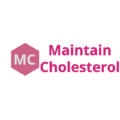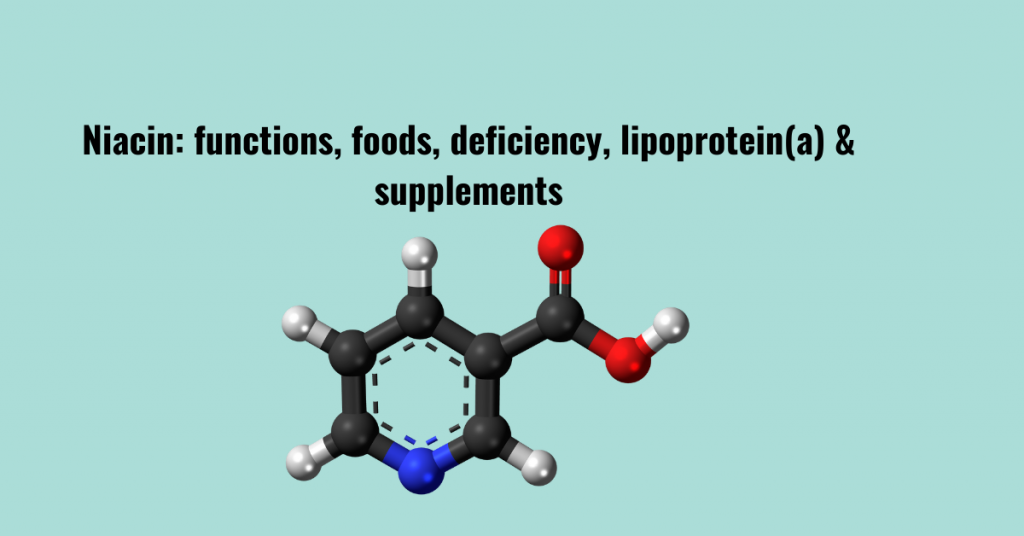Niacin: functions, foods, deficiency, lipoprotein(a) & supplements
Table of Contents
Introduction
What is niacin and what it does?

Niacin, also known as vitamin B3 and nicotinic acid, is an important nutrient. In fact, every part of your body needs it to function properly. As a supplement, it may help lower cholesterol, ease arthritis and boost brain function, among other benefits. However, it can also cause serious side effects if you take large doses.
Different forms of niacin (vitamin B3)
Vitamin B3 is a vitamin that includes three forms:
- Nicotinamide (niacinamide),
- Niacin (nicotinic acid), and
- Nicotinamide riboside.
All three forms of vitamin B3 are converted within the body to nicotinamide adenine dinucleotide (NAD). NAD is required for human life. People are unable to make NAD within their bodies without either vitamin B3 or tryptophan. Nicotinamide riboside was identified as a form of vitamin B3 in 2004.[1] The group is also occasionally referred to as vitamin B3 complex.
Does body make our own nicotinic acid?
Your body gets this nutrient through food but also makes small amounts from the amino acid tryptophan. Vitamin B3 is one of eight water-soluble B vitamins. It’s also known as nicotinic acid, niacinamide and nicotinamide.
Foods rich in nicotinic acid

Vitamin B3 is water-soluble vitamin. So we need to get it from our daily diet. Our bodies do make a small amount of B3, but we get most of it from our food. Rich sources of B3 are:
- red meat
- chicken
- oily fish
- eggs
- milk and dairy products
- bread
- fortified breakfast cereals
A vitamin B3 deficiency is rare in the USA. A severe lack of vitamin B3 can lead to a condition called pellagra. Symptoms include dry, itchy skin (dermatitis) and diarrhea.
Functions of niacin
The function of vitamin B3 are many. It is involved in several biochemical reactions or enzymatic reactions. Like all B vitamins, niacin plays a role:
- In converting carbohydrates into glucose,
- Metabolizing fats and proteins,
- Keeping the nervous system working properly;
- It also helps the body make sex- and stress-related hormones and
- Improves circulation and cholesterol levels.
How niacin functions in the body?
The niacin that comes through food we eat enters all the tissues in the body. From there it is transformed into different biologically active forms and carries out different functions.
All tissues in the body convert absorbed vitamin B3 into its main metabolically active form. The active form is coenzyme nicotinamide adenine dinucleotide (NAD).
More than 400 enzymes require NAD to catalyze reactions in the body, which is more than for any other vitamin-derived coenzyme.
NAD is also converted into another active form, the coenzyme nicotinamide adenine dinucleotide phosphate (NADP), in all tissues except skeletal muscle.
The coenzymes NAD and NADP are required in most metabolic redox processes in cells where substrates are oxidized or reduced.
NAD is primarily involved in catabolic reactions. It transfers the potential energy in carbohydrates, fats, and proteins to adenosine triphosphate (ATP). ATP is the cell’s primary energy currency.
NAD is also required for enzymes involved in critical cellular functions:
- Such as the maintenance of genome integrity,
- Control of gene expression, and
- Cellular communication
NADP, in contrast, enables anabolic reactions:
- Such as the synthesis of cholesterol and
- Fatty acids, and
- Plays a critical role in maintaining cellular antioxidant function.
Does niacin reduce cholesterol levels?
As a cholesterol treatment, there are good studies showing that niacin can:
- Boost levels of good HDL cholesterol;
- Lower triglycerides and
- Modestly lower bad LDL cholesterol.
Does niacin reduce lipoprotein(a) levels?
Lipoprotein(a) is a molecule similar to LDL cholesterol. It is made of LDL cholesterol by attaching another protein molecule called apo(a).
Recent research has shown that lipoprotein(a) is the real bad cholesterol compared to LDL cholesterol. It is an independent and emerging risk factor for heart diseases.
Niacin or Vitamin B3 reduces lipoprotein(a) levels floating in the blood stream. Statins are unable to reduce lipoprotein(a). Rosuvastatin is said to reduce lp(a) cholesterol to some extent.
New discoveries like PCSK9 inhibitors have just been launched in the market to lower lipoprotein(a).
Are on statins? Please consult your doctor. Ask for advice on getting your lp(a) cholesterol levels checked. Also ask him if taking niacin is good for you.
There are several niacin supplements either alone or in combination with other nutrients.
Niacin Flush
Nicotinic acid when uses directly causes what is called as flush. This is one of the side effects of niacin. Nicotinic acid causes severe itching, flushing and hot flashes. It disappears after a few days of regular intake. Therefore there are sustained release tablets available which do not cause flushing in the body.
Niacin Deficiency
The deficiency of any vitamin in the body causes some problem or the other in the body. The deficiency affects the optimal performance of the specific biochemical reaction.
Deficiency of niacin causes:
- Pellagra
- Digestive problems like vomiting, constipation or diarrhea;
- Neurological problems.
- Today, most people in the developed world get plenty of niacin in their diets and pellagra is rare.
Niacin deficiency Treatments
The recommended daily allowance (RDA) for niacin is 16 milligrams per day for men. It is 14 milligrams per day for women.
Good sources of niacin include red meat, fish, poultry, fortified breads and cereals, and enriched pasta and peanuts.
Milk contains tryptophan, which our body converts it into nicotinic acid.
There are several supplements available available. The supplement should contain minimum 20 mg of niacin to help prevent niacin deficiency.
Summary
Niacin, vitamin B3 is an important water soluble vitamin. It performs more than 400 biochemical reactions in the body. It gets converted in the body into 3 important active forms- NAD, NADH, NADP. Deficiency of niacin cause pellagra. It lowers LDL and increases HDL levels. It also reduces elevated lipoprotein(a) levels.

